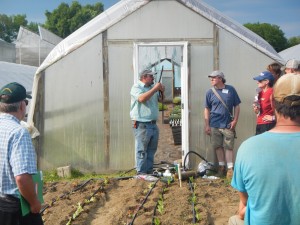As southern areas of the region still need rain, northern areas have received more than enough over the past few weeks. Given these recent heavy storms, we thought we would focus on measures farmers are using to adapt to such events, which are predicted to become more and more common with climate change. We welcome Catherine Lowther, faculty at Goddard College, for another guest blog profiling a local farmer working hard to adapt.
Alan LePage is a fifth generation Vermont farmer and has been growing vegetables organically for 40 years at the LePage Farm in Barre, VT. He sells his produce at the Montpelier Farmer’s Market and shares his knowledge in his radio show “The Curse of the Golden Turnip” on the Goddard College radio station, WGDR, at 91.1 FM or at http://www.wgdr.org Sunday mornings from 6:00-9:00.

http://capitalcityfarmersmarket.com/wp-content/uploads/2014/10/Mkt-10-18-18-600×400.jpg
The biggest climate change problem Alan has experienced is “gully washer storms,” localized storms when 4 – 6 inches of rain falls in a short period of time. His soil is clay loam and is slow to drain. When that much rain falls in early summer on fresh tilled ground, a farmer can lose everything. There can be serious damage with sandy soil too, but it drains more rapidly. With clay loam there will be standing water, he can’t get onto his fields with equipment for some time, and he has lost crops as a result. To manage these events, he has switched to using extensive raised beds. To create the raised beds, he uses a bog harrow that has two large harrow disks that toss dirt up to the side to form the beds. If the soil is loose, the harrowing alone works fine, but if it is clumpy, it will need to be raked after harrowing.
If water runs off into the valleys on the sides of the beds and the ground is bare, this will create ravines, so he leaves the areas between the beds protected by weeds to hold the soil. To prevent the weeds from going to seed, he trims them with a weed wacker.
He is also making extensive use of plastic to cover beds to protect them against rain. In years with successions of intense rainstorms, he has covered entire seedings with 10×500’ tarps. This is especially helpful when seeding in June for a fall harvest. He has tried using hay mulch, but a big storm will push hay into the mud.
Most of his fields are on a slight incline, and using raised beds has obviated the damage that occurs in intense storms. He has had to be more careful about the placement of beds so that there is less chance of getting a river running through a field. In general, he finds it is very important when planning a sloped field to terrace it to minimize the downward direction of water flow. It also helps to break a field into sections with strips of cover crops that will absorb and break the flow of water.
He has also had to do a lot more plant staking, especially of fava beans. On Memorial Day weekend in 2013, he had 6 inches of rain, and if he hadn’t had his fava beans staked and roped, rain would have knocked them down, they would have gotten caught in the mud, and he would have lost the whole crop. Corn can stand up again after a rain, but fava beans are a Mediterranean plant and aren’t used to intense water events.
Insects
Alan is seeing more squash borers and squash bugs. Squash bugs inject a toxin that deforms plants. There can be enormous populations of them in late summer, and their little white progeny sometimes cover the ground. They damage cucumbers and zucchini. He never used to see them, and now they are a perennial problem.
He has also had tarnish plant bugs. These suck plant juices, attack the primary meristem of a plant, and destroy it. They also sting strawberry blossoms so that the fruit is deformed. They are especially active at temperatures in the 90s. Tarnish plant bugs are very difficult to treat. He uses an organic product called Entrust that costs $600/lb., or people can use the same thing in Monterey Garden Insect Spray that is ready to spray on. Growers can use it only three times per season per crop because insects will build up resistance to it, but it does work.
Higher Temperatures
Alan has not had too much trouble with heat as his soils are high in clay and slow to warm. He has noticed that in a very hot summer, it is hard to get lettuce to germinate. It won’t germinate in soils over 75 degrees, goes into dormancy, and comes up next year. He has tried starting seeds in flats under lilac trees and keeping them watered to keep them cool. Spinach also doesn’t like high temperatures, especially if it is late summer seeded and soil temperatures are too high.
Drought
Alan has had only one year of drought. Many farmers are near rivers and irrigate their fields from the rivers, but he has a hill farm. In 2001, he had to truck in water to keep his plants alive. Others growing on well-drained land lost a lot. The spring for his house also went dry.
Benefits of Warming
On the positive side, increasing temperatures over the last 30 years have made it possible to plant some crops he could never grow before. September is especially warmer. Sweet potatoes are now viable, especially if there is good soil, and he has had some spectacular sweet potato crops. He is also planting “yard long” beans, an Asian species that requires a long season.
Catherine Lowther, PhD
Catherine is faculty in the Sustainability program, and Chair of the Sustainability Committee at Goddard College in Plainfield, VT. We will be collaborating with her and her students on several blog posts during this project. Many thanks for their contributions!

